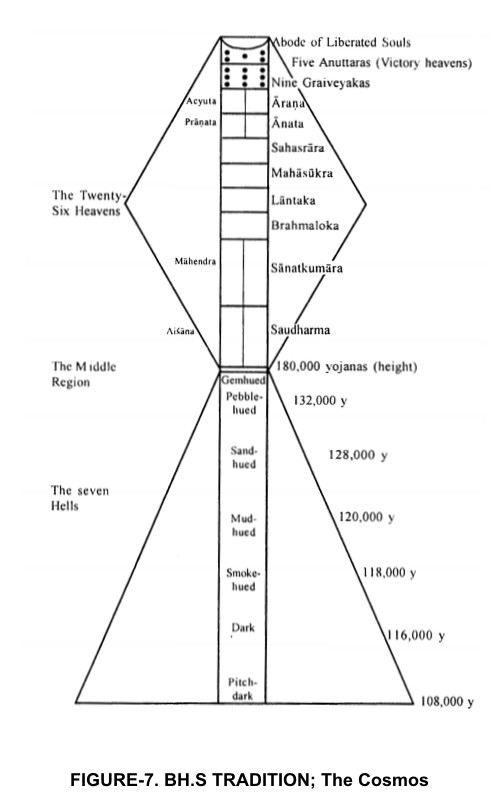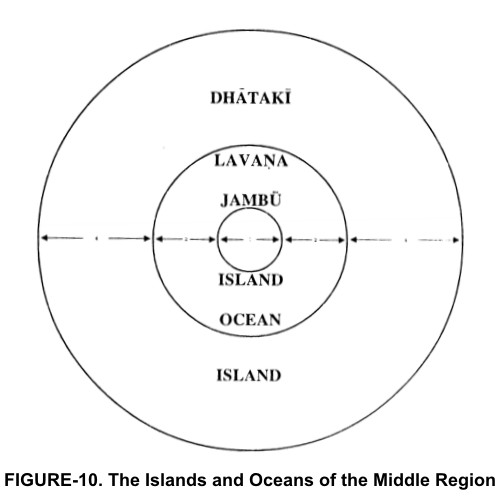It has already been indicated that the universe consists of three compartments—the upper (ūrdhva) the lower (adhaḥ) and the middle section (madhya), with measures evident from the figure-1. The Bh.S does not describe the measurement of the compartment of the universe in numerical figures. The figures are found in the latter works.[63] Accordingly, the whole universe in height is of 14 and in breadth 49 Rajju[**].
(i) The Upper Section
The upper part of the universe is somewhat less than 7 Rajju.[64] The upper universe comprises of heavenly abodes, for the gods and more and godlier in succession from the initial first to the twenty-sixth. The Bh.S mentions the upper section of fifteen types including nine Graiveyakas and five Anuttaravimānas [65] and also the uppermost earth named 'Iṣatprāgbhāra'.[66] In total the heavens are twenty-six in numbers. (See figure-7) Sarvārthasiddhi, a commentary on Tattvārtha, accepts thirty-nine heavens.[67] (See figure-8). The names of heavens are clear from the figures. The highest heaven is named Sarvārthasiddhi. Iṣatprāgbhāra, one of the earths and the abode for the liberated beings, is situated twelve yojanas above the heaven Sarvārthasiddhi.[68] It measures 45 lake yojanas in length and breadth. The circumference of it measures a little more than the breadth by three times. In the center it measures 8 yojanas.[69] It is white and pure like the conch or the pearl and therefore, it is named as 'Sītā'. Another name for it is 'Siddha-śilā' because in the uppermost one-sixth portion of this earth, the liberated souls reside.[70] One yojana above there is the end of the universe. Therefore, it is recognized by the name 'Lokānta' or 'Lokāgra' i.e. the summit of the universe also.[71]
(ii) The Middle Section
The middle universe is the abode for the humans and animals. The middle section (region), in elevation, is eighteen hundred yojanas and in extension, equivalent to the dimension of innumerable islands and oceans.[72] The islands and ocean have special names such as Jambu island, Lavaṇa ocean and so on.[73] According to the scriptures and the later works[74] the islands and oceans are concentric rings, the succeeding ring being double the preceding one in breadth. At the center of all these islands and oceans is the round island of Jambu and Mount Meru is at its navel (See figure-10).
Jambu Island is perfectly round like a potter's wheel. It is just in the center of the middle region of the cosmos. The diameter of the island is 100,000 yojanas[75] (909,000 miles). Mount Meru in the middle of the island is 99000 above and 1000 yojanas below the earth. The base of Mount Meru touches the top of the first infernal land and its peak touches the bottom of the celestial region above.[76]
Jambu is ringed by the Lavaṇa ocean (salt ocean) which is twice as wide as Jambu. The Lavaṇa ocean is ringed by Dhātakikhaṇḍa island. Similarly it continues with Puṣkara Island, the Puṣkara ocean, Varuṇa island, the Varuṇa ocean, Kṣīra island, the Kṣīra ocean and so on unto the Svayambhuramaṇa ocean that rings the last island of the same name. In this way there are innumerable islands and oceans in the mid-part of the universe (See figure- 10). The middle regin is again divided into fifteen Karmabhūmi and thirty Akarmabhūmi. Besides, there are many mountains as depicted below in the figure-11 in appendix.
(iii) The Lower Section
The part of the universe that is below the middle section is known as the lower section (adho-loka). The lower section is a little more than seven rajjus in dimentions.[77] There are seven lands, one below the other.[78] They are known as seven 'Narakas' (Hells). Mostly, the infernal beings live in these lands. Each land is having a wider base than the one above. From top to bottom, these lands are commonly recognised as the gem-hued, pebblehued, sand-hued, mud-hued, smoke-hued, dark and pitch-dark lands (See figure-1). Each land floats on a dense ocean, which floats on a layer of dense air, which floats on a layer of thin air, which floats on self-supporting space.[79]
The seven infernal lands indicated as gem-hued etc. are technically known as 1. Ratnaprabhā, 2. Śarkarāprabhā, 3. Bālukāprabhā, 4. Paṅkaprabhā, 5. Dhūmaprabhā, 6. Tamaḥprabhā, 7. Mahātamaḥprabhā.[80] The dwelling places of the infernal being are within these lands. They inhabit all of the infernal lands except for the top 1000 Yojanas and the bottom 1000 Yojanas of each.[81] According to the Bh.S and other philosophical texts,[82] the number of strata and dwelling places in the neather lands are as follows:
| Table No. 1 | ||
| Infernal or Neather lands | Number of Strata's | Number of Dwelling Places |
| Gem-hued (Ratna-Prabhā) | 13 | 3,000,000 |
| Pebble-hued (Śarkarā-Prabhā) | 11 | 2,500,000 |
| Sand-hued (Bālukā-Prabhā) | 09 | 1,500,000 |
| Mud-hued (Paṅka-Prabhā) | 07 | 1,000,000 |
| Smoke-hued (Dhūma-Prabhā) | 05 | 300,000 |
| Dark (Tamaḥ-Prabhā) | 03 | 99, 995 |
| Pitch-dark (Mahātamaḥ-Prabhā) | 01 | |
The seven neather (infernal) lands are divided by huge gaps occupied by layers of dense oceans, dense air, thin air and interspace.[83] The dense ocean between each land is 20,000 Yojanas deep, but the layers of dense and thin air and the interspace increase, the further down the cosmos they are, so that the deepest layers are above the seventh infernal land. According to Tattvārthā dhigamasūtram,[84] none of the layers and inter space are less than innumerable Yojanas deep. According to the Sarvārthasiddhi, the layers of dense ocean, dense air and thin air are each 20,000 Yojanas deep. (See figure-8)
Here to be clear about the three circles of layers of dense ocean, dense air, and thin air some detail is necessary. The Jain Acharyas have thought of their nature and colour etc., e.g., in the Tattvārtha Vṛtti, the dense ocean has been identified with the circle of air.[85] In the Tattvārtha Rajavārtika, the dense ocean is explained as solidified water[86] Abhayadevasūri explains the dense ocean as solidified water, like iceberg.[87] According to Acharya Akalaṅka, the dense ocean, dense air and thin air are rings. The nather region is situated on the dense ocean, the dense ocean is situated on dense air, the dense air is situated on thin air, the thin air on space and the space is situated in itself.
In the Tiloyapaṇṇatti, the colours of the rings are also described. The colour of the dense ocean is like that of the cow's urine, the color of dense air is like that of pea, and the colour of thin air is manifold.[88] In Tattvārtharajavārtika, the colours are described somewhat differently. The colour of the dense ocean is like that of the pea and the colour of dense air is like that of cow's urine, and the colour of thin air is unmanifest.[89]
Rajju: A rajju is a conceptual measure consisting of innumerable pramaṇa Yojanas, each pramaṇa yojana being almost equivalent to eight thousand miles.
Uttara.; 36/57—bārasehiṃ joyaṇehiṃ savvaṭṭhassuvariṃ bhave īsīppabbharaṇamā u pudhavi chattasaṅṭṭhiyā.
Uttara.; 36/57-62—joyaṇassa u jo tassa koso uvarimo bhavi • tassa kasassa chabbhae siddhanogahana bhavi •
Ibid., 9/2/3-4; 11/9/83—evaṃ khalu jambudīvādīva divī lavaṇādīyā samuddā taṃ ceva jāva asaṅkhejjā dīvasamuddā paṇṇattā............
Bh.S; 11/10/109—ayaṇṇaṃ jambuddīve dīve savvadīva-samuddāṇāṃ savvabbhantarāe jāva egaṃ joyaṇasahassaṃ āyāma-vikkhambheṇaṃ.............
Bh.S; 6/6/120; 11/10/92—aheloyakhettaloe ṇaṃ bhante! kativihe Goyamā! sattavihe paṇṇatte, taṃ jahā—rayanappabhā puḍhavī paṇṇatte aheloyakhettaloe jāva ahesattamā puḍhavi aheloyakhettaloe.
(i) Bh.S; 1/6/298-303-305—evaṃ loyante ya sattame ya taṇuvāe, evaṃ ghanavāe, ghanodahi.............. (ii) Tattvārthādhigamasūtram; 3/1 Bhāṣya
Tattvārthādhi.; p. 234—ratnaprabhādyāṣu bhūmiṣu urdhvamadhaścaikaikaśo yojaṇasahasramekaikaṃ varjayitvā madhye narakaḥ bhāvānti.
Ibid., p. 233—sarve ghanodadhayo viṅśatiyojanasahasrāṇi, ghanavātatanuvātāstvasaṅkhyeyāni, adho'dhastu ghanatarā viśeṣaṇeti.
Sthānāṅga Vṛtti; p. 166 tatra ghanaḥ—styano hīmaśilavad udadhiḥ—jalanicayaḥ, sa ca iti ghanodadhiḥ.
Tiloyapaṇṇati; 1/268—gomuttamuggavaṇṇa ghanodadhi taha ghananilo vāu tanuvādo bahuvaṇṇo rukkhassa tayaṃ va vayatiyam
 Dr. Samani Chaitanya Pragya
Dr. Samani Chaitanya Pragya





